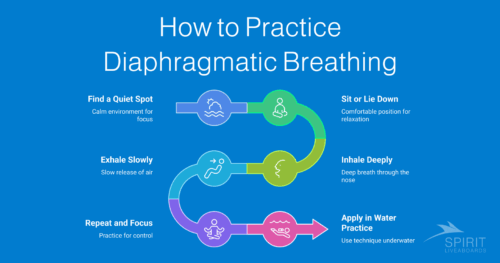The Art of Breath Control: The Foundation of All Excellent Dive Skills
In our journey of Mastering Core Dive Skills, we begin with the most fundamental and profound element, an act we perform some 20,000 times a day without thought: breathing. On land, it’s a reflex. Underwater, it becomes a conscious skill—an art that can define the quality of your entire dive experience.
Many divers believe their air supply depends on their lung capacity or physical fitness. While those factors play a role, the single biggest determinant lies in how you breathe. This in-depth Amadive article will go beyond simple tips. We will dive into the physiological science, analyze common mistakes, and provide a step-by-step guide to mastering diaphragmatic breathing—a small change that can yield massive results: longer dives, a calmer mind, and better buoyancy control.
The Science of Air Consumption: Why Rapid Breathing Burns a Tank
To breathe efficiently, we need to understand that the goal of respiration is not just to get Oxygen in, but to get CO2 out.
- The Respiratory Cycle: When you inhale, your lungs absorb Oxygen (O2). When you exhale, you expel Carbon Dioxide (CO2), a waste product of your metabolism.
- The Breathing Trigger: The “urge to breathe” is not triggered by a lack of O2, but by the buildup of CO2 in your bloodstream.
- The Vicious Cycle of Shallow Breathing: When you are anxious or exerting yourself, you tend to breathe rapidly and shallowly (chest breathing). This style of breathing is very inefficient at expelling CO2. The CO2 builds up faster, triggering your brain to send the signal “breathe even faster!”. This loop not only drains your tank but also creates a feeling of breathlessness and anxiety.
The Most Common Mistake: The “Chest-Breathing Diver”
Try this now: Take a deep breath. Did your chest rise? If so, you’re a chest breather. This is an inefficient habit most adults develop. It uses only the top portion of the lungs, ignoring the larger, lower lung capacity where the most efficient gas exchange happens.
The Solution: The Diaphragmatic Breathing Technique

This is the natural way babies breathe and the secret of yogis, singers, and experienced divers.
- What is the Diaphragm? It’s a large, dome-shaped muscle located just below your lungs. When you inhale using your diaphragm, it contracts and moves down, drawing air deep into the bottom of your lungs.
- How to Do It Consciously:
- Inhale through your nose (or mouth on scuba) slowly for a count of 4-5 seconds. Focus on expanding your belly. Imagine you’re inflating a balloon in your stomach. Your chest should remain relatively still.
- Hold for a brief pause (1-2 seconds).
- Exhale through your mouth slowly and with control for a count of 6-8 seconds. Let your stomach slowly fall.
- Why it Works:
- Maximizes Gas Exchange: Drawing air deep into the lungs maximizes the surface area contact between the air and your blood vessels, allowing for far more efficient CO2 removal.
- Calms the Nervous System: A long, slow exhale activates the vagus nerve, which sends a relaxation signal to your brain, lowering your heart rate and blood pressure. This is your most powerful anti-anxiety tool underwater.
Practical Drills to Make it a Reflex
- The “Book on the Belly” Land Drill:
- Lie on your back on the floor. Place a small book on your abdomen. Practice breathing so that the book rises on your inhale and falls on your exhale. Your chest and hand should not move. Do this for 5 minutes a day.
- The “Zen Minute” Underwater Drill:
- Amadive’s Experience Tip (E-E-A-T: Experience): We encourage all our students to do this. When you first descend and establish buoyancy, take exactly one minute. Don’t swim, don’t do anything. Just kneel or hover and focus 100% on performing the diaphragmatic breathing technique. This single minute will set the rhythm for your entire dive, making you calmer and significantly more air-efficient.
The Direct Connection: Breath and Buoyancy
Your lungs are a natural BCD, capable of far finer adjustments than any piece of equipment. Once you’ve mastered your breathing, you can:
- Gently rise over a coral head simply by taking in a full, deep breath.
- Slowly sink a few inches to get a closer look at a small creature just by exhaling completely.
- Minimize your use of the BCD inflator/deflator buttons, helping you move more gracefully and conserve air.
Conclusion: Breathing is the Foundation of Finesse
Switching from chest breathing to diaphragmatic breathing is the single most profound and simple change you can make to elevate your diving. It requires conscious practice, but once it becomes second nature, it serves as the foundation for every other skill, from efficient air consumption and staying calm in any situation to achieving perfect buoyancy control.
